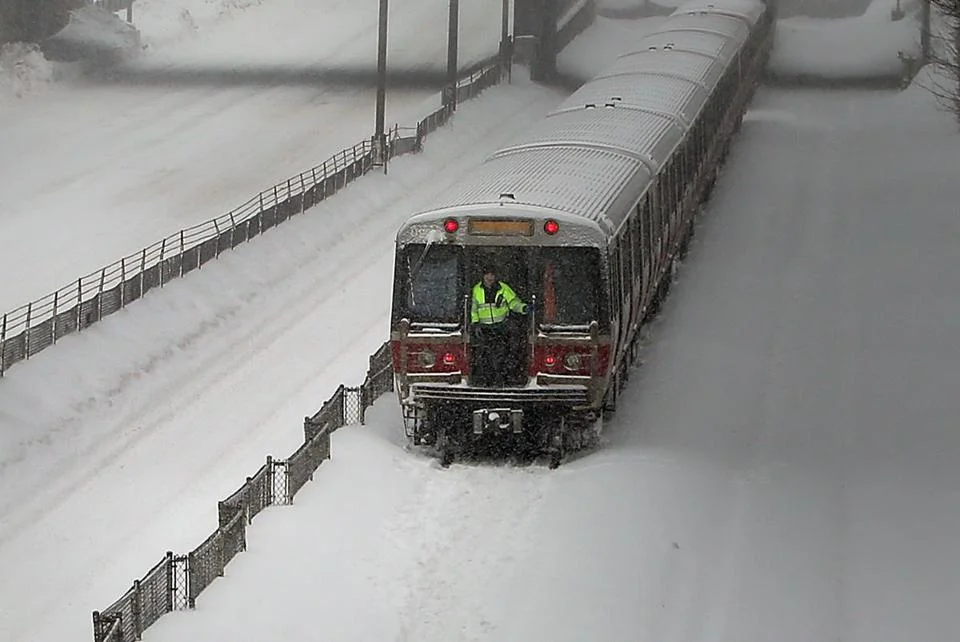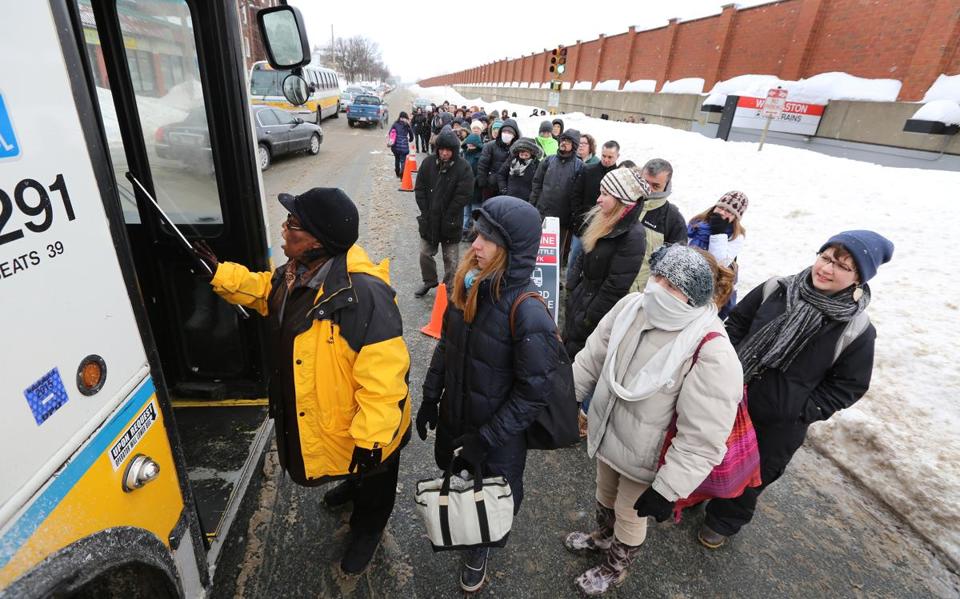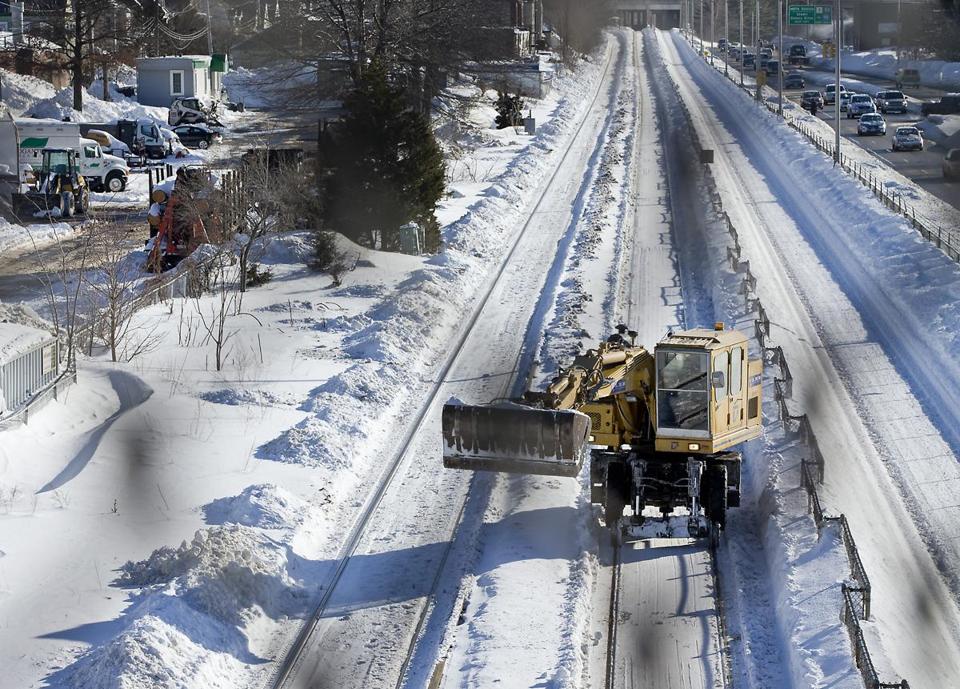
An Emergency Transportation Plan to Fix Boston's Transit Crisis
Yesterday we learned that due to decades of neglect the MBTA will need at least 30 days to restore service to the normal level of delays, signal problems and disabled trains we're used to. While there is plenty of blame to go around, right now we must focus on the current emergency.
Yesterday we learned that due to decades of neglect the MBTA will need at least 30 days to restore service to the normal level of delays, signal problems and disabled trains we're used to. While there is plenty of blame to go around, right now we must focus on the current emergency.




We must act quickly to implement a temporary transit network that would people to resume their lives before the state's economy collapses and half the city's population is out of work. Mayor Walsh and MBTA General Manager Beverly Scott should seek help from cities and transit agencies who have experience with natural disasters. With bold political leadership and around 1,000 buses from across the northeast we can put an emergency transportation plan into action.
For guidance we should look to MTA New York City Transit, which in 2012 implemented emergency "bus bridges" connecting Brooklyn and Manhattan two days after Hurricane Sandy knocked out all subway service in the city's core (photos). The city used simple cones to create dedicated bus lanes along the shuttle route and police officers to enforce the lanes and keep over 200 buses moving on each route. MTA also ran a long-term shuttle route to replace the A line in Queens and a year earlier replaced suspended commuter rail service after Hurricane Irene.
Here and now, a network of emergency shuttle bus routes must be created based roughly on known travel patterns. Bus routes would not exactly mimic subway corridors but they would get you into the city's core where you can walk or use what's left of the T. Some routes would use dedicated bus lanes and receive priority over all other traffic, with police enforcement, while other corridors would be open only to buses. For all of the issues with bus service, the MBTA does a great job running shuttle bus links such as Harvard-Alewife and Lechmere-North Station when things are planned in advance.
Cars carrying fewer than 3 occupants would be prohibited from entering the city or using major highways inside Route 128. Slug lanes would allow those who must drive from suburban areas to pickup additional passengers before continuing on. Large parking lots along I-495 and Route 128 can be turned into park-and-ride lots with bus shuttles operating in dedicated bus lanes on all major highways.
Bikes must be part of the solution. It is certainly cold outside but desperate times call for desperate measures. Better to ride 3 miles in the cold than wait for a bus in the cold for the same 15 minutes, and every 50 bikes represents one more bus available elsewhere. Designating corridors like Washington St, Massachusetts Ave, Huntington St and Commonwealth Ave for buses and bicycles only would enable reasonably fast limited-stop bus service while giving people people a safe place to ride. Secure bicycle parking tents can be setup in several downtown locations and an emergency ordinance could require most office buildings to allow bikes inside until full subway service resumes.
Walking should be encouraged whenever possible in order to minimize stress on the transit system. Bostonians have not experienced a transit strike in recent decades but experience from other cities shows people will gladly walk a few miles if they can. Currently our sidewalks are a treacherous mix of snow and ice, so vehicle lanes can be converted to pedestrian lanes until sidewalks are clear, with some key roads open to buses and pedestrians only.
Some of these measures may sound extreme, but desperate times call for desperate measures, and I believe even the harshest critics of transit would be surprised by how well the city would function if they would just allow a demonstration.
At the very least, this plan would prevent the total collapse of the region and it is our chance to show definitively that a fast, frequent and comprehensive transit network is invaluable to the entire region. Eventually we'll wonder how we ever lived without one.
Podcast 09 - Snow Cripples MBTA, Governor Baker Presents Statewide Budget Cuts
It's been a terrible few weeks for the chronically neglected MBTA as record snowfall and epic traffic congestion stalled buses and trains throughout the region. Damage to vehicles and infrastructure following 50 disabled trains on Monday forced the MBTA to suspend rail service for the third time this year as crews work to clear tracks and repair ancient equipment.
MBTA General Manager Beverly Scott blamed old equipment and lack of investment for the recent troubles and said she hopes we can pursue the "systemic, planned, serious, bold reinvestment" that the system needs.
Meanwhile, our new Republican Governor Charlie Baker called the system's recent performance "unacceptable" and blamed T management while admitting he has not yet called the GM. Baker insisted his proposed $40 million transportation budget cuts will not affect transportation service.
How did we get to this point? Where do we go from here?
[Lede Photo: A MBTA bus sits stuck in a snowbank during a snow storm in Boston, Massachusetts February 2, 2015. Photo by: Dominick Reuter/Reuters]
It's been a terrible few weeks for the chronically neglected MBTA as record snowfall and epic traffic congestion stalled buses and trains throughout the region. Damage to vehicles and infrastructure following 50 disabled trains on Monday forced the MBTA to suspend rail service for the third time this year as crews work to clear tracks and repair ancient equipment.
MBTA General Manager Beverly Scott blamed old equipment and lack of investment for the recent troubles and said she hopes we can pursue the "systemic, planned, serious, bold reinvestment" that the system needs.
Meanwhile, our new Republican Governor Charlie Baker called the system's recent performance "unacceptable" and blamed T management while admitting he has not yet called the GM. Baker insisted his proposed $40 million transportation budget cuts will not affect transportation service.
How did we get to this point? Where do we go from here?
Where is serious revenue going to come from? Mostly local sources like cities, towns, real estate development and value capture fees.
For its part, the MBTA should make a serious effort to improve emergency management and communications, to better respond to disruptions and stem the accelerating loss of rider confidence in a safe, efficient transportation network. This applies to everything from everyday bus bunching to severe weather to prolonged rail disruptions.
Cities must take bold steps to ensure people can walk on public ways. Sidewalks covered in snow and ice encourage people to drive cars instead of walking or using transit. The current system of begging and threatening fines to property abutters is not working. Potential solutions could include community cooperatives (Ann Arbor) and city plowing of sidewalks (Rochester). Send in your ideas!
The future of our latest attempt at late-night service is uncertain. An extended span of service offers many benefits beyond college students going to bars (like equitable access to jobs and social activities). Yet without a real political commitment and proper planning for special routes running all night, it will be hard to keep this limited pilot program going. The MBTA will hold public meetings soon. Examples from Vancouver, San Francisco, Chicago, Toronto.
Sign the T4Massachusetts petition to lawmakers for proper T funding. And if that fails, one rider has started a crowdfunding page to raise money for the T (BostInno). We recommend the LinkPass Plus.
--> Don't miss our new feature: Transit News Roundup.
Did we miss something or get it wrong? Send us your questions, comments and ideas for topics or guests >> contact us. Or share your thoughts in the comments below.
The Transit Matters Podcast is your source for transportation news, analysis, interviews and more. We focus on sustainable transportation planning, operations and policies in Boston and beyond. Transit Matters is a joint project of local transit advocates Marc Ebuña, Jeremy Mendelson and Josh Fairchild.
Like this project? Share it around, tell your friends and colleagues, and subscribe to the RSS feed (iTunes) to be notified of new posts and episodes.
Comm Ave: from auto mile to people mile
Nearly a century ago, Commonwealth Avenue from Kenmore Square, heading west to Packard's Corner, was home to over a hundred automobile dealers and associated vendors. For much of the twentieth century, while riding the trolley, you would have passed showroom after showroom, parking lot after parking lot, all calling out for you to buy a car and drive away.
Contributor: Matthew Danish
ALLSTON — Nearly a century ago, Commonwealth Avenue from Kenmore Square, heading west to Packard's Corner, was home to over a hundred automobile dealers and associated vendors. For much of the twentieth century, while riding the trolley, you would have passed showroom after showroom, parking lot after parking lot, all calling out for you to buy a car and drive away.
Problems with this street have been known for decades. As the Brighton Item noted in 1948:
Something has to be done with Commonwealth Avenue, the broad and landscaped parkway that is perhaps Allston-Brighton's handsomest thoroughfare and undoubtedly its most lethal one. Multi laned, well paved, and alluring to the motorist made fretful by the cold molasses in Boston's ever cooking traffic jam, it is the Circe of highways.
In 2014, much has changed. We now know that people who are walking, biking and riding the T along Comm Ave strongly outnumber [PDF] the drivers. For example, for the area just west of the BU Bridge, the breakdown comes out as 7 to 3 in favor of non-car modes.
|
Time criteria |
Mode |
Count |
Percentage |
|
Peak Hour |
Green Line "B" |
2887 |
30.9% |
|
|
Car |
2780 |
29.8% |
|
|
Walking |
2507 |
26.9% |
|
|
Biking |
609 |
6.5% |
|
|
57 Bus |
364 |
3.9% |
|
|
BU Shuttle |
182 |
2.0% |
|
|
Total |
9329 |
100% |
Almost all of the automobile businesses have left, and the buildings have been largely converted into other uses. At long last, the city has produced plans for the second phase of the long awaited street reconstruction of Comm Ave, Phase 2A from Amory Street to Alcorn Street:
But these plans have turned out to be highly disappointing, by seemingly encoding the values of 1974 rather than 2014: with wider travel lanes goading higher automobile speeds, with sidewalk narrowing requiring the removal of older trees, with no provision for improved bicycle facilities on a busy corridor, and without addressing the problematic long blocks that impede pedestrian movement across the street.
A similar style plan has already been implemented for phase 1 of the corridor, from near Kenmore Square up to University Road. How did that turn out? Well, they added a lot of trees, brick crosswalks, and street furniture to make it look prettier. But the same problems that plague the phase 2A design also apply to the phase 1 design and we can see how it worked out: not well. The design of phase 1 has proven completely inadequate for handling the volume of pedestrians generated by Boston University in between classes.
The crossings of Comm Ave are not sufficient in number and are poorly timed for pedestrians. And the sidewalks have been narrowed by the addition of poorly thought-out street furniture zones to the point that the remaining space overflows with a flood of students between classes.
Even while the pedestrians are squeezed, the drivers are treated to a generous motorway with wide lanes and few interruptions. The various trees and fences create the sense of a divided highway, and the long blocks practically beg you to put the pedal to the metal.
As a result, phase 1 represented a triumph of aesthetics over sense and safety. The continuing trickle of car/pedestrian and car/bike collisions attests to the problem.
Fortunately, these collisions have been non-fatal (and therefore, it seems, non-newsworthy). There is typically some form of victim-blaming involved, "oh, why was he running across the street," without any consideration of how the poor street design creates the problem by encouraging higher car speeds, and by making it unnecessarily obnoxious for pedestrians to cross the street as needed.
So when I heard that the phase 2A design was mostly an extension of the phase 1 design further west on Comm Ave, I became alarmed. We missed our opportunity to fix the obvious problems with phase 1. We should not miss it again. But the city was very secretive about phase 2A. The only public meeting, at 25% design, was held in March of 2012, and poorly advertised as usual. Various advocacy organizations, including LivableStreets, did submit letters with suggestions that would have greatly improved the design. But nothing was heard in response.
Actually, the only reason we heard anything at all is because the city suddenly filed plans in December of 2013 with the tree warden to have the remaining in-scope, older trees removed. So two years after the comment letters were submitted, we finally learned that basically nothing was taken into consideration and the 75% design remained mostly the same in principle. The trees were to be taken away and the sidewalk narrowed with essentially no community input or process. We also learned that no further process is planned. The design of phase 2A has been funded by Boston University and they are not interested in making anything but the most minor of changes.
This is simply unacceptable. I understand that Boston University is a major abutter to the street. I appreciate that they have been willing to provide funds. They have put together a decent transportation master plan. I know that they care about their students' safety, even if I believe that they are mistaken in their methods. But if they expected to simply drop a design on the city without public input, without a chance to fix the obvious problems with it, without incorporating modern pedestrian- and bicycle-friendly street design, then they are wrong and must be challenged by members of the community.
In short, LivableStreets and I believe the following changes must be made to the design of Comm Ave phase 2A:
- Minimize sidewalk narrowing, make intersections pedestrian friendly, and extend curbs.
- The travel lanes must not be widened, instead they must be calmed to reduce speeds.
- Additional crossings of the street must be added to cut up the long blocks.
- Integrate with the MBTA plans to consolidate stations and add signal priority.
- Comm Ave is a designated cycle-track on the bicycle network plan, and that begins now.
What you can do:
- Please sign LivableStreets' online postcard to add your name and a short message about why you care about Commonwealth Avenue
- Contact your elected officials at the city and the state level
- Let the Boston Transportation Department know your concern about the city's commitment to its Complete Streets guidelines
Categories
- Children (1)
- Diversions (1)
- Olympics (1)
- MAPC (2)
- Red–Blue Connector (2)
- Urban Design (3)
- Bus (4)
- Fares (4)
- Late Night Service (4)
- MBTA ROC (4)
- Silver Line (4)
- Snow (5)
- Blue Line (8)
- Emergency (8)
- Orange Line (8)
- Public Comment (8)
- Maintenance (9)
- Operations (9)
- Signage (9)
- Fare Collection (10)
- Labs (11)
- Safety (11)
- Planning (12)
- Communication (14)
- MBCR (14)
- MassDOT (14)
- Green Line (16)
- History & Culture (16)
- Red Line (18)
- MBTA Bus (21)
- Commuter Rail (24)
- Advocacy (26)
- Capital Construction (28)
- Politics (30)
- Podcast (35)
- News (38)
- Media (40)
- Funding (42)
- Statements (50)
- MBTA (57)



